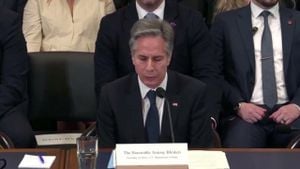Stellantis, one of the world’s largest automakers, announced significant leadership changes on December 1, 2024, following the unexpected resignation of CEO Carlos Tavares. His departure came as the company grappled with declining profits and internal challenges, paving the way for new leadership dynamics.
Tavares, 66, who had been at the helm since the formation of Stellantis through the merger of PSA Group and Fiat Chrysler Automobiles in 2021, left his position with immediate effect. The board's decision, noted independent director Henri de Castries, was driven by "different views" on addressing the group’s profit slump. This marked the fastest exit of a CEO from the multinational company, signaling unrest within the executive ranks.
According to reports, the shuffling of executive positions was not entirely unanticipated. Sources indicated Tavares had been facing mounting pressure due to disappointing sales figures, particularly from North America, which is typically a powerhouse market for Stellantis. By mid-2024, Stellantis had seen North American sales drop 20% compared to previous years, leading to heightened scrutiny over Tavares’s leadership decisions.
Stellantis’s announcement also revealed plans for interim leadership during the search for Tavares’s permanent replacement, with John Elkann, the company's chairman, leading the interim executive committee. Elkann stated, "The process to appoint the new permanent chief executive officer is well under way, managed by a special committee of the board, and will be concluded within the first half of 2025." This leadership committee is expected to navigate Stellantis through this transition period as it evaluates potential candidates to steer the company back to success.
While Tavares’s early tenure at Stellantis began with optimism and profitability, challenges soon emerged. The automaker faced difficulties integrating its 14 brands, which include Chrysler, Jeep, and Ram. Compounding these issues were delays and setbacks with new model launches due to problems with electronic components and the industry-wide struggle for the transition to electric vehicles. Like many competitors, the company cited rising competition from Chinese manufacturers and its own struggles to pivot swiftly to electric drivetrains as significant barriers to success.
Tavares's leadership style, characterized by strict cost-cutting measures and ambitious profitability targets, might have inadvertently alienated some segments of Stellantis’s operations. Sources hinted at tensions between Tavares and the American brands under Stellantis, particularly related to performance expectations and product strategies.
Just prior to his resignation, reports surfaced detailing how Tavares had resisted pressure to maintain the company’s high-performance Hemi V8 engine, which has been iconic for American muscle cars. Insiders recounted how many executives and brand leaders, particularly from North America, advocated for keeping the Hemi alive, citing its popularity among customers. Tavares, conversely, pushed for greener initiatives and emphasized the need to align with global automotive trends leaning heavily on alternative energy solutions.
Given Tavares’s unfulfilled aspirations of reaching double-digit profit margins, which he had linked to his lucrative compensation package, the executive's exit was seen by some as inevitable. Following the announcement of his departure, the company projected profit margins of only 5.5% to 7% for the upcoming year, substantially lower than Tavares's goals.
With the company's financial indicators trending negatively, Stellantis has been actively working to reshape its leadership. Notably, the former chief of Dodge, Tim Kuniskis, has returned to Stellantis after briefly leaving earlier this year. Kuniskis's return has raised questions about the direction he will take Ram Trucks and other North American brands moving forward.
Kuniskis, who began with Chrysler as a spare parts sales manager back in 1993, has been instrumental during pivotal moments at both Dodge and Ram. His strategies during the pandemic spurred success for the brands, which many hope he can replicate moving forward as he once again takes his place among Stellantis’s executives.
Looking to the future, Stellantis faces questions about its next steps and how to address fierce competition and the urgent need for electric vehicle advancements. Automaker executives and industry analysts are closely watching how the company will adapt its product offerings and operational strategies under new leadership.
Overall, Tavares’s reign will be remembered for its ups and downs, mirrored by the broader struggles of traditional automakers as they navigate the complex shifts within the global automotive market. With the auto industry rapidly changing and the pressure intensifying, how Stellantis adapts remains to be seen. Will new leadership bring renewed vitality and vision to the storied company? Only time will tell.



